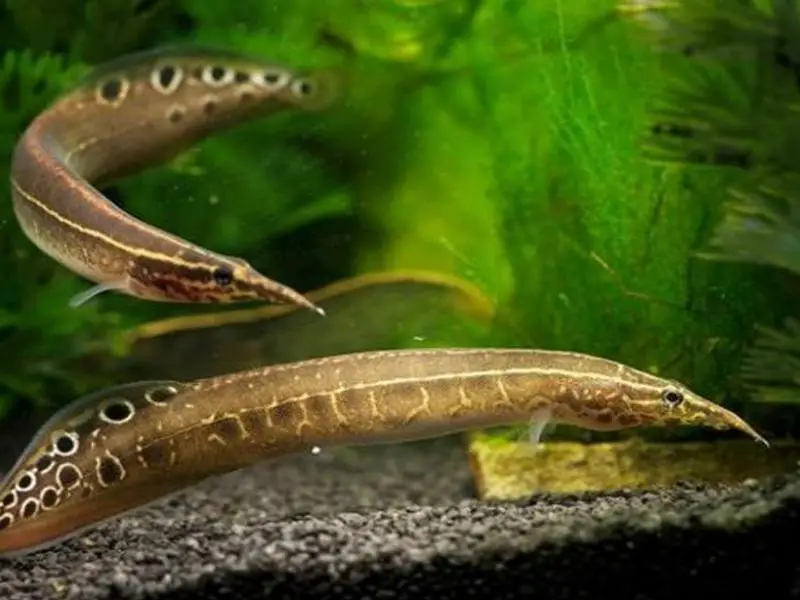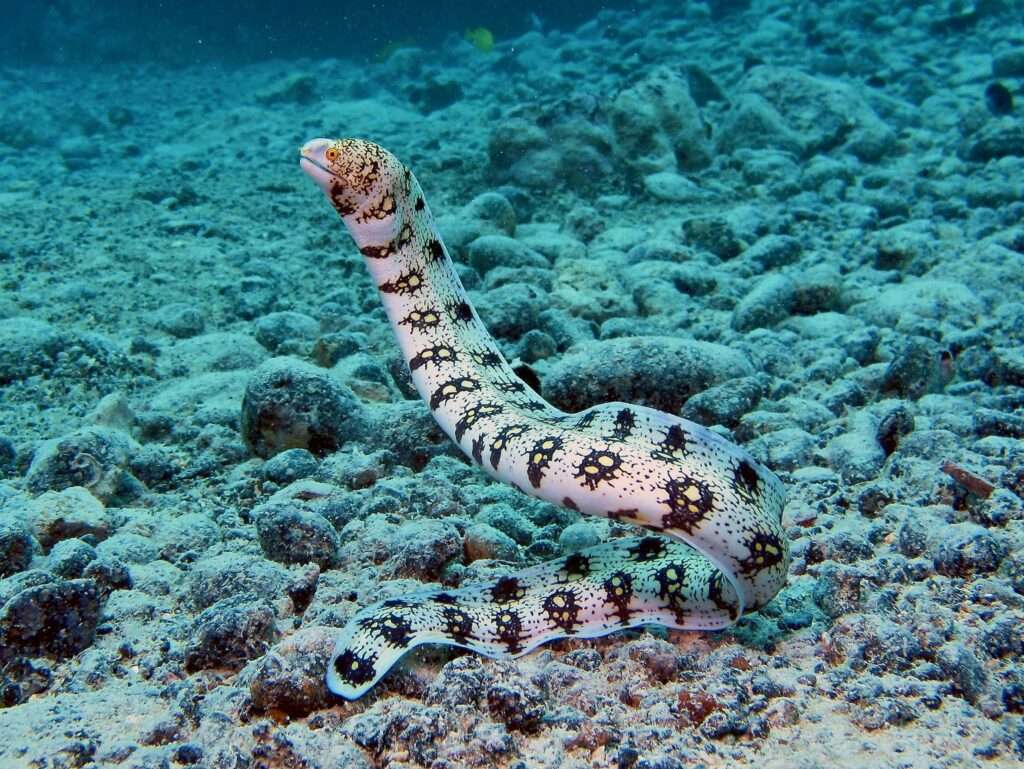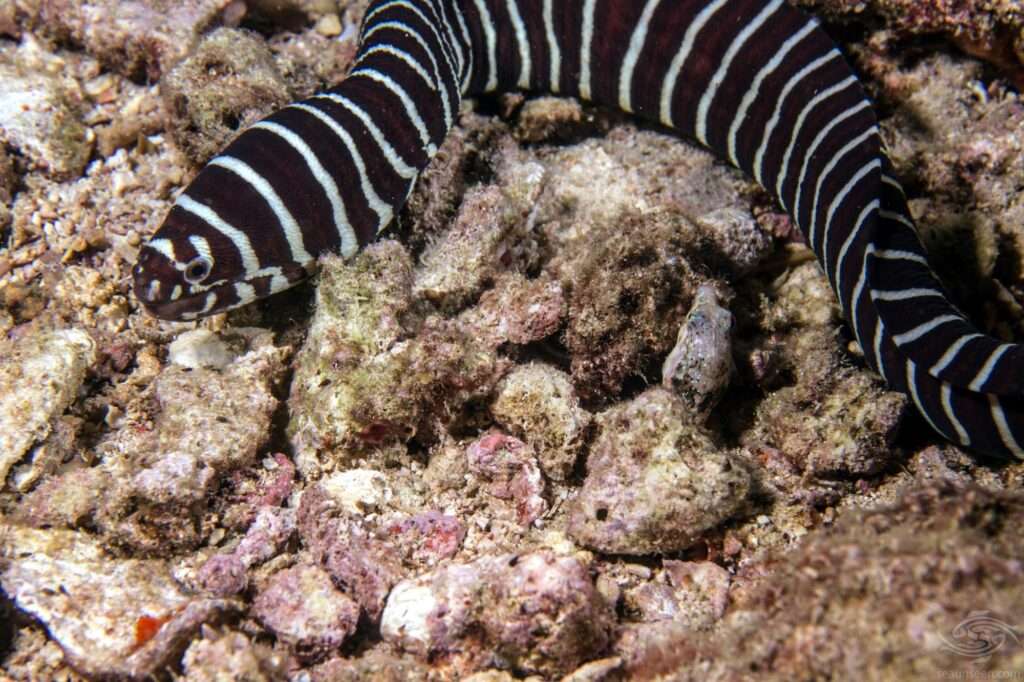
Beautiful spiny eel Macrognathus siamensis is known as the Peacock Eel. Depending on where it comes from, its color and patterning may vary slightly. However, their main hue is light brown, with a narrow pale yellow stripe extending from the corner of the eye to the end of the tail. They typically have three to six decorative “eye spots” adorning the upper back of the body and the base of the dorsal fin. The common names Siamese Spiny Eel, Peacock Spiny Eel, Striped Peacock Eel, and Spot-Finned Spiny Eel are also used to refer to them.
Despite not being regarded as real eels, all members of the Mastacembelidae family of spiny eels have eel-like body shapes. The Peacock Eel has a pointed snout and a body that is elongated but quite stout. The size of this aquarium eel is slightly around a foot (30 cm), therefore it doesn’t get too large. Juveniles can be housed in a tank of around 20 gallons, but larger species require a larger space. A tank measuring 36 inches long and holding around 35 gallons is required for adults. These guys are escape artists, so make sure you have a secure cover.
The extremely resilient Peacock Spiny Eel is widely accessible. It’s an excellent beginning fish for anyone who want to keep spiny eels. It often feeds willingly and easily adjusts to life in an aquarium. With a maximum adult size of little about a foot long, it is likewise quite small. However, because it is nocturnal, you might not always see it. By burying itself in the substrate, it typically hides during the day.
Peaceful peacock eels can be housed in a communal aquarium with bigger fish. They get along well with a variety of tank mates, as you can see in the picture above where this mature specimen is kept alongside a Jack Dempsey cichlid. This species will also get along with members of its own kind as long as they are of a similar size, unlike many spiny eels.
As Keeping Pet Face Difficulty
Eels are typically recommended for more experienced aquarists rather than fish keepers who are just starting out. This eel can be quite sensitive to change and frequently needs some time to overcome its timidity. Getting them to eat during the first two weeks can be really challenging. They do need water that is exceptionally pure. They have very thin scales covering their bodies, making them vulnerable to parasites and fungi, as well as extremely sensitive to treatments. Copper-based treatments should be avoided because these fish do not respond well to them. If cared for properly, these eels get fairly large and can live for a long time. The bottom of the aquarium is where peacock eels will spend the most of their time. A tank that is roughly 24 inches long and 20 gallons can house small specimens. Larger specimens will require a larger space; adult tanks should be at least 36 inches long and 35 gallons in capacity.
They thrive in water that is soft to medium-hard, has adequate movement, and has ample oxygenation. These fish need crystal-clear water. At least 10 to 15 times an hour should pass before the tank water changes. These fish benefit greatly from an undergravel filter since it increases oxygen levels throughout the tank while also lowering waste. To ensure appropriate flow and oxygenation, airstones, powerheads, or canister filters might be used. Due to their propensity for escape, spiny eels require a tight-fitting cover.
They prefer aquariums that are dimly lit or have plants floating around to help diffuse the light. They may burrow into the substrate if it is made of fine sand or gravel in their tank. In order for them to feel secure in their new home, make sure they have a lot of hiding spots. To offer it some gloomy spaces to retreat, add more decor like rocks, caves, and tree roots. Long spiny eels thrive in caverns made of PCV tubing. Make sure to securely lay any heavier decorations at the bottom. Although these fish don’t actively do harm, their size and propensity for digging enable them to uproot anything in their path, even plants. The creation of numerous hiding spots is necessary for the eel to feel secure in the tank.

Habitat
They prefer aquariums that are dimly lit or have plants floating around to help diffuse the light. They may burrow into the substrate if it is made of fine sand or gravel in their tank. In order for them to feel secure in their new home, make sure they have a lot of hiding spots. To offer it some gloomy spaces to retreat, add more decor like rocks, caves, and tree roots. Long spiny eels thrive in caverns made of PCV tubing. Make sure to securely lay any heavier decorations at the bottom. Although these fish don’t actively do harm, their size and propensity for digging enable them to uproot anything in their path, even plants. The creation of numerous hiding spots is necessary for the eel to feel secure in the tank. They will come out at night to eat worms, crustaceans, and insect larvae.
Diet and Feeding
Carnivores include the Half-banded Spiny Eels. They eat worms, crustaceans, and insect larvae at night. They favor a diet of live, fresh-frozen items like brine shrimp, black worms, earthworms, or bloodworms, as do all spiny eels. Although it is not always possible, certain spiny eels can be made to eat freeze-dried brine shrimp or bloodworms. Make sure their tank mates are too big to fit in their mouths because they will also consume little fish. This fish prefers to be fed at night when the lights are out because it is a nocturnal animal. Eels only need to be fed once every two to three weeks, and some may reject food supplied more frequently than that.
Description
The Peacock Eel has an extended body and a pointed nose. The caudal fin, which is fairly small, is reached by the extension of the dorsal and anal fins. These fish can reach lengths of over 12 inches (30 cm) and typically live for 8 to 18 years.
This eel’s main color is light brown, and it has a narrow, pale yellow stripe that extends from the eye to the tail’s base. Its popular name, “Peacock” Eel, refers to the three to six ocelli, or “eyespots,” that can be seen near the base of the dorsal fin. Depending on where it was made, there can be some color and pattern differences.
Table





